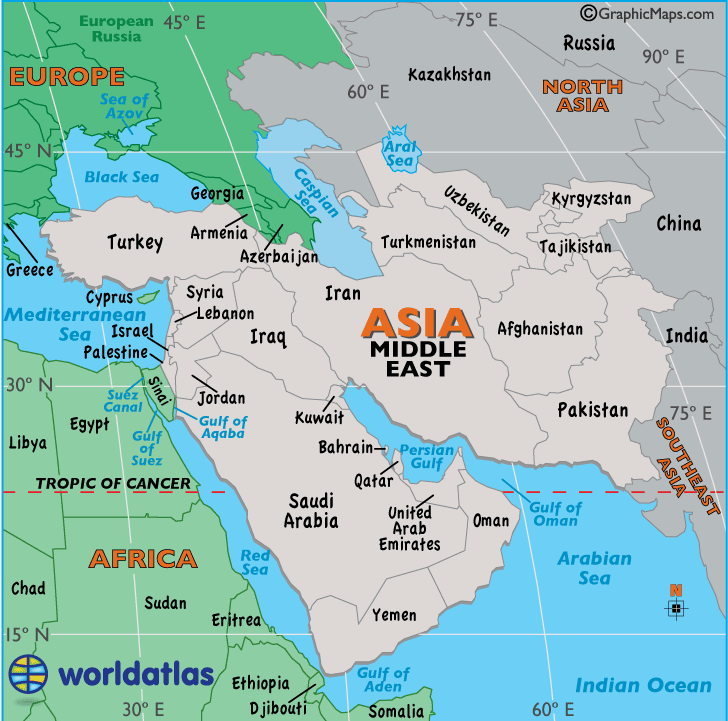Middle East

What Is The Middle East And What Countries Are Part Of It?
The Middle East is a geographical and cultural region located primarily in western Asia, but also in parts of northern Africa and southeastern Europe. The western border of the Middle East is defined by the Mediterranean Sea, where Israel, Lebanon, and Syria rest opposite from Greece and Italy in Europe. Egypt in Africa also borders the Mediterranean and is sometimes considered as part of the Middle East, while Turkey and Cyprus literally connect Europe to Asia and oscillate between being called European and Middle Eastern.
Armenia, Azerbaijan, and Georgia, all located just northeast of Turkey, are at times associated with the Middle East, Europe, Asia, or as their own separate region. South of the Mediterranean Sea, the Red and Arabian Seas surround the southern part of the Middle East. Saudi Arabia, Yemen, and Oman border these waters, with Iraq and Jordan connecting them to the western part of the region. At the center of the Middle East rests the Persian Gulf, cutting into the region and giving it its hook-like shape. Countries along the Persian Gulf include the United Arab Emirates, Qatar, Bahrain, Kuwait, and Iran.
The eastern and northern borders of the Middle East are somewhat difficult to define. Both Afghanistan and Pakistan border Iran to the east, but Pakistan’s shared history with India causes it to sometimes be seen as part of South Asia instead of the Middle East. Some of the countries bordering Iran and Afghanistan’s north, such as Turkmenistan, Tajikistan, and Uzbekistan, are sometimes included within the northern borders of the Middle East, but are other times seen as their own Central Asian region alongside Kyrgyzstan and Kazakhstan.
There are also several unrecognized or partially recognized states within the Middle East. Palestine, which is made up of the Gaza Strip and West Bank regions in and around Israel, declared its independence in 1988 and is currently recognized as independent by 134 countries, though it is not an official member of the United Nations and is not considered to be its own countries by every G-8 nation except Russia. Abkhazia, Nagorno-Karabakh, and South Ossetia are all located within the Caucasus region around Armenia, Azerbaijan, Georgia, and Russia and all declared their independence during the 1990s, with limited recognition internationally. Northern Cyprus declared its independence in 1983 but is only recognized as a sovereign state within the UN by Turkey, with every other member considering it as simply part of Cyprus. Some borders within the Middle East are similarly difficult to define as a result of territorial disputes between countries within the region. Some examples include the island of Abu Musa in the Persian Gulf, which is administered by Iran by claimed by the United Arab Emirates, the Golan Heights plateau, which was part of Syria until it was occupied and annexed by Israel during the Six-Day War, and the region of Kurdistan, which is officially a part of northern Iraq but also has an autonomous status.
Geography Of The Middle East
The majority of the Middle East region is characterized by a warm desert climate. Weather in this climate is very high during the summer and can reach dangerous levels, with parts of Iraq and Iran having recorded feel-like temperatures of over 160 degrees Fahrenheit (71 degrees Celsius). Average temperatures during the summer usually rest at around 120 degrees Fahrenheit (49 degrees Celsius), while the winters are somewhat milder. This climate also has very little rainfall, resulting in large desert regions. Areas of the Middle East surrounding the Mediterranean, such as Israel and Lebanon, instead boast a warm Mediterranean climate similar to parts of Greece and Italy, while Turkey’s territory stretches over a variety of arid and continental climate. The northern regions of the Middle East in Iran, Afghanistan, and Central Asia are closer to a steppe climate, with colder winters but still very little precipitation.
As a result of its arid climate, the Middle East is home to several of the world’s largest deserts. The Syrian Desert, which also stretches into Jordan, Iraq, and Saudi Arabia, combines both traditional desert and steppe geography, while the Arabian Desert around Yemen, Oman, Jordan, Iraq, and the Persian Gulf contains more of the rolling sand dunes which often characterize desert imagery. Indeed, the Rub ‘al-Khali, or Empty Quarter, at the center of the Arabian Desert is the largest sand-only desert on the planet and receives as little as 1.2 inches (30 millimeters) of rainfall per year. The Sahara Desert, which stretches across northern Africa and which is perhaps the best-known desert in the world, reaches into the Middle East by way of Egypt.
Despite the proliferation of deserts within the region, the Middle East also has several seas, gulfs, and rivers. It shares the Mediterranean Sea with Africa and Europe and the Black and Caspian Seas with Eastern Europe. The famous Suez Canal and Gulf of Suez run between Egypt’s African territory and its Sinai region bordering Israel in Asia, while the equally renowned Nile River flows from the Mediterranean Sea through Egypt and well into the African continent. The Dead Sea borders Israel to the West and Jordan to the East and is among the saltiest lakes in the world and is also lowest point on the Earth’s land surface, while the Red Sea is shared by both the Western Middle East and parts of Eastern Africa. The massive Tigris and Euphrates rivers begin in the mountains of eastern Turkey, flowing through Syria and Iraq out into the Persian Gulf. The Persian Gulf, along with the Gulfs of Arden and Oman, connect the central and southern regions of the Middle East to the Arabian Sea and ultimately the Indian Ocean.
Using the most inclusive possible definition of the region as per the outlines listed previously, the total landmass of the Middle East is roughly 3.82 million square miles (9.9 million square kilometers). The largest countries in the region are Saudi Arabia (800 thousand square miles or 2.1 million square kilometers), Iran (580 thousand square miles or 1.5 million square kilometers), Egypt (384 thousand square miles or 995 thousand square kilometers), and Pakistan (340 thousand square miles or 881 thousand square kilometers). The smallest countries in the Middle East are Bahrain (295 square miles or 765 square kilometers), Cyprus (3,568 square miles or 9,241 square kilometers), Lebanon (3,950 square miles or 10.2 thousand square kilometers), and Qatar (4,473 square miles or 11.6 thousand square kilometers).
History of the Middle East
The Middle East is often referred to as the “Cradle of Civilization,” and a brief look at the region’s history clearly explains why this is true. This part of the world, and particularly the Mesopotamia region around the Tigris and Euphrates rivers, is home to many of humanity’s earliest accomplishments. Neolithic humans here made their first transitions from nomadic to agricultural lifestyles by inventing the wheel, basic agriculture, and the beginnings of the written word roughly 12,000 years ago. Ancient Sumer was the first civilization on Earth, and produced the oldest known piece of literature, the Epic of Gilgamesh, which is now over 4000 years old. This region was also home to the ancient Akkadian, Babylonian, and Assyrian empires, while farther West the Middle East region saw the unification and rise of Ancient Egypt. Several Persian empires originating in modern Iran also rose to dominance in the Middle East, while the Romans and their successor state in the East, the Byzantine Empire, eventually controlled the region from the Mediterranean coasts up to the Euphrates River.
The Middle East is also the origin point for many of the religions and belief systems which help define modern civilizations today. The region was home to the ancient Kingdom of Israel and thus fostered the Jewish religion. Jesus is believed to have been born in Nazareth, which is located in what is now the northern region of Israel, and indeed early Christianity traces its origins back to the Middle East. The region is also the birthplace of Islam, as the Prophet Muhammad was born in Mecca (now the capital of Saudi Arabia) in around AD 570. Several other belief systems also trace their origins to the Middle East, such as the pantheon of Ancient Egyptian gods, the deities of Ancient Sumer, and the Zoroastrianism and Manichaeism of Ancient and Classical Persia.
Following the establishment of Islam, much of the Middle East came under control of Arab dynasties, followed by a series of Turkic peoples. The first of these was the Seljuks, followed by the influx of Mongol invasions during the 13th century, and finally by the Ottomans, who established an empire based in Constantinople (now Istanbul) in the middle of the 15th century. The Ottoman Empire controlled much of the Middle East for several centuries, though there were competing powers such as the Persian Safavids and the growing colonial powers Britain, France, and Russia.
The Ottoman Empire was dismantled during the course of World War I, resulting in a vacuum of power in the Middle East in which the British and French occupied further stretches of territory up until the end of World War II, where after a series of conflicts both European powers began to retreat from the region. The 20th century saw the formation of several new nations within the Middle East, such as Saudi Arabia, Iran (which had been previously known as Persia), Jordan, Lebanon, Syria, and Israel. The region also saw a series of major conflicts during this century, such as the Arab-Israeli War, the Iran-Iraq War, and the Gulf War. The Middle East’s recent history during the 21st century has also been marred with violence.
The September 11 terrorist attacks on the United States in 2001 prompted an invasion of Afghanistan and later Iraq as part of a continuing “War on Terror,” while a series of revolutions beginning in 2010 called the Arab Spring involved major protests and the overthrowing of dictatorial regimes in Tunisia, Egypt, Libya, and Yemen. Revolutionary activity in Syria resulted in harsh governmental retaliations leading into the prolonged Syrian Civil War, a larger conflict is still ongoing and has killed between 250,000 and 470,000, displaced over 7.5 million within Syria, and forced over 4 million people to flee the country as refugees.
New militant terrorist organizations have also taken hold in the region in recent years, most notably the Taliban in Afghanistan; al-Qaeda, which had orchestrated the September 11 attacks; and the Islamic State (IS), also known as ISIS (Islamic State of Iraq and Syria), ISIL (Islamic State of Syria and the Levant), or Daesh, which has proclaimed its own state and caliphate with the intent of forcibly implementing its own interpretation of Islam and Sharia law.
Demographics of the Middle East
Stretching the definition of the Middle East to include its widest borders as per the parameters outlined earlier, the population of the region rests at around 690 million people. The most populous countries in the Middle East include Pakistan (~193 million), Egypt (~90.6 million), Iran (~79 million), and Turkey (~78.7 million), while the least populated countries are Cyprus (~1.1 million), Bahrain (~1.4 million), Qatar (~2.4 million), and Armenia (~3 million).
Despite the historical rise and prominence of Islam in the Middle East, the many belief systems which originated in the region allow it to maintain a highly diverse religious makeup today. Indeed, out of the entire global Muslim population only roughly 20% live within the Middle East. This being said, Islam is still dominant and is the official state religion in most countries of the region. Over 90% of people in Afghanistan, Azerbaijan, Egypt, Iran, Iraq, Jordan, Kuwait, Oman, Pakistan, Saudi Arabia, Tajikistan, Turkey, Uzbekistan, and Yemen adhere to Islam, while Muslims make up between 50-89% of the population in Bahrain, Lebanon, Qater, Syria, Turkmenistan, and the United Arab Emirates.
The two largest denominations of Islam in the Middle East are Sunni and Shia, though Sunni is the more dominant sect in most countries of the region. The countries that have Shia majorities in the Middle East are Bahrain, Iraq, and Iran. Shia Islam specifically is the official religion of Iran, which is the country with the highest percentage of its adherents in the world (90-96%) and with its largest global population (30-35%). Orthodox Christianity is the most prominent Christian denomination in the Middle East, with several major groups including the Armenian, Coptic, and Greek Orthodox churches. Christianity is the dominant religion in Armenia, Cyprus, and Georgia, and Christian minority populations of at least 10% are found in Bahrain, Egypt, Lebanon, Qatar, Syria, Turkmenistan, and the United Arab Emirates. Lebanon is of particular note for having a nearly even split between Islam and Christianity, being roughly 54% Muslim and 40% Christian and having a Christian as its president. Israel is unique for being the only country in the world with a majority Jewish population, though it officially has no state religion. Roughly 75% of its population adheres to Judaism, with about 17% adhering to Islam. Among Israel’s Jewish population, roughly 66% are Secular, 26.5% Orthodox, 3.2% Conservative, and 3.9% Reform.
Arabic is the most common language in the Middle East. It is the sole official language in Bahrain, Egypt, Jordan, Kuwait, Lebanon, Oman, Qatar, Saudi Arabia, Syria, the United Arab Emirates, and Yemen. Iraq has two official languages, with Arabic spoken by the majority of its population and Kurdish spoken by in the autonomous Kurdistan region. Persian is the second-most spoken language in the Middle East, and it has specific dialects in the region. The most common form of Persian is Farsi, which is the sole official language of Iran and is spoken by the vast majority of the population there. The Tajiki dialect of Persian is the official language of Tajikistan, with Russian recognized as a regional language, and Dari is the Persian dialect spoken primarily in Afghanistan. Afghanistan actually has two official languages: Dari and Pashto, a Central Asian language related to (but separate from) Persian. Turkish is the third-most popular language in the Middle East. It is the sole official language of Turkey and one of the two official languages of Cyprus, alongside Greek.
Several Middle Eastern nations also have their own languages specific to their country. Urdu is one of the two Hindustani languages (alongside Hindu) and is the national language of Pakistan, though English is also an official language. Uzbek, a Central Asian Turkic language, is the official language of Uzbekistan, with Russian and Karakalpak (also a Turkic language) recognized as regional languages. Turkmen, another Turkic language from Central Asia, is the sole official language of Turkmenistan, though Russian has some limited recognition. Armenian, Azerbaijani, and Georgian are the sole official languages for their respective countries. Israel is the only country in the world to have Hebrew as a national language, but there are actually two official languages in the country: Hebrew and Arabic. Aside from official and national languages, there are also a wide variety of minority languages which are a product of the diverse cultures, patterns of migration, and economic activities of the Middle East. These spoken languages include (but are not limited to) Berber, Circassian, English, French, Gagauz, Hindi, Romani, Russian, Somali, and several Modern Aramaic dialects.







